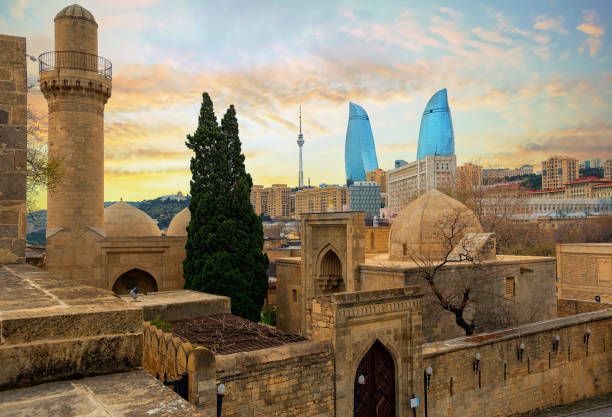History of Azerbaijan
The Renaissance period of Azerbaijan’s history was beginning, as a result of the establishment of independent states, an awakening in all spheres of political, economic, and cultural life.
The establishment of local states (Sajids, Shirvanshahs, Salarians, Ravvadis, Shaddadis, Sheki rule) after Sassanid and Arab enslavement lasting up to 600 years, the transformation of Islam into the main monotheistic religion throughout the country played an important role in the ethnic evolution of the Azerbaijani people.
Islam, at the same time, in a historical environment where the various feudal dynasties that rule Azerbaijan are often interchangeable, also played a progressive role in uniting as a united force against foreign invaders.
After the decline of the Arab caliphate, the role of the Turkic-Islamic empires increased in the Caucasus, as well as in the entire Middle East, from the middle of the ninth century. Sajid’s, Shirvanshahs, Salaries, Ravvadis, Shaddadis, Sheki rulers, Seljuks, Eldenizs, Mongols, Elkhanids-Hulakuls, Shepherds, Jalayirs, Teymurids, Ottomans, Garagoyunlular, Aghgoyunlular, Safavids, only Turks-rulers, Afshars They have left a deep mark on the history of statehood not only in Azerbaijan, but also in the South Caucasus as a whole, but in the entire Middle East.
In the 15th and 18th centuries and beyond, the culture of statehood in Azerbaijan became even richer. During this period, the Garagoyunlu, Aghgoyunlu, Safavi, Afshar, and Gajar empires, which covered a large area of the East, were directly ruled by the Azerbaijani dynasties.
This important factor has a positive impact on Azerbaijan’s domestic and international relations, expands the scope of the military and political influence of our country and people, the field of activity of the Azerbaijani language, created favorable conditions for further development of material and spiritual culture of the Azerbaijani people. During this period, the Azerbaijani states played an important role in international relations, the military and political life of the Middle East, as well as in European-Eastern relations.
During the reign of the great Azerbaijani statesman Uzun Hasan (1468-1478), the Aghgoyunlu empire became a powerful military-political factor in the entire Middle East. The culture of statehood in Azerbaijan has further developed. Uzun Hasan pursued a policy of creating a strong centralized state covering all Azerbaijani lands. He drafted a special “Legislation” for this purpose. The great ruler translated the Holy Quran into Azerbaijani and wrote an Oghuznama called “Kitabi-Diyarbakiriya” to Abu Bakr al-Tehrani, a prominent scientist of the time.
At the end of the 15th and the beginning of the 16th centuries, Azerbaijani statehood entered a new stage in its historical evolution. Uzun Hasan’s grandson Shah Ismail Khatai (1501-1524), a prominent statesman, completed the work started by his grandfather and was able to unite all the lands of north and south of Azerbaijan under his rule.
A single, centralized Azerbaijani state, with its capital city of Tabriz, the Safavid state, emerged.
During the Safavid rule, the culture of public administration in Azerbaijan increased even more. Azerbaijani became the state language.
As a result of successful reforms and domestic and foreign policies implemented by Shah Ismail, Shah Tahmasib, Shah Abbas, and other Safavid rulers, the Safavid state became one of the most powerful empires in the Middle East.
Nadir Shah Afshar (1736-1747), a prominent Azerbaijani commander who came to power after the fall of the Safavid state, further expanded the borders of the former Safavid Empire. In 1739, this great ruler from the Afshar-Turkish province of Azerbaijan conquered northern India, including Delhi. However, the plans of the Azerbaijani ruler to create a powerful centralized state in this vast area did not materialize.
After the death of Nadir Shah, the vast empire he ruled collapsed. While Nadir Shah was still alive, local states were established in the lands of Azerbaijan, which fought for freedom and aspired for independence. Thus, in the second half of the 18th century, Azerbaijan was divided into small states, khanates, and sultanates.
At the end of the 18th century, the Azerbaijani dynasty, the Gajars (1796-1925) came to power in Iran. In time, the Gajars began to pursue a policy of re-subordinating all their territories under the rule of the Karakoyunlu, Aghkoyunlular, Safavids, and finally Nadir Shah, including the Azerbaijani khanates, to the central government.
Thus began a period of protracted wars between the Gajars and Russia, which sought to occupy the South Caucasus.
Azerbaijan has become a battleground between two great powers and according to the Gulustan (1813) and Turkmenchay (1828) treaties, Azerbaijan was divided between two empires: Northern Azerbaijan joined Russia, and South Azerbaijan joined the Gajar-ruled kingdom of Iran.
Thus, in the subsequent history of Azerbaijan, new political-geographical concepts emerged: “Northern Azerbaijan” (or “Russian Azerbaijan”) and “Southern Azerbaijan” (or “Iranian Azerbaijan”).
In order to establish itself in the South Caucasus, Russia massively relocated the Armenian population from neighboring countries to the occupied Azerbaijani lands, especially to the mountainous regions of Karabakh, the territory of the former Yerevan and Nakhchivan khanates. An “Armenian province” was created artificially and for a special purpose in the territories of Western Azerbaijan bordering Turkey – the territory of the former Yerevan and Nakhchivan khanates. Thus, the foundation of the future Armenian state was laid on the lands of Azerbaijan.
In addition, Russia abolished the independent Albanian Church in 1836 and subordinated it to the Armenian Gregorian Church. Thus, more favorable conditions were created for the Gregorianization and Armenianization of the Christian Albanians, the ancient population of Azerbaijan. The groundwork was laid for new territorial claims of Armenians against Azerbaijanis. Not content with all this, Tsarist Russia pursued a more ugly policy: arming the Armenians against the Turkish-Muslim population and committing massacres against the Azerbaijanis. Thus began the era of genocides against Azerbaijanis and the entire Turkish-Muslim population of the South Caucasus.
The struggle for freedom in northern Azerbaijan has resulted in unprecedented tragedies. The Dashnak-Bolshevik government of S. Shaumyan, who seized power here, committed a terrible genocide against the Azerbaijani people in March 1918. Brother Turkey helped Azerbaijan. The liberation movement won. On May 28, 1918, the first democratic republic in the East, the Azerbaijan Democratic Republic, was established in Northern Azerbaijan.
The Azerbaijan Democratic Republic, the first parliamentary republic in the history of the Azerbaijani people, was also the first example of a democratic, legal and secular state in the whole East, including the Turkic-Islamic world.
During these six months, the first Azerbaijani Parliament, acting under the name of the National Council of Azerbaijan and consisting of 44 Muslim-Turkish representatives, made very important historical decisions. Our first Parliament declared the independence of Azerbaijan on May 28, 1918, took over the country’s management, and adopted the historic Declaration of Independence.
Azerbaijan

parliamentarian of the Azerbaijan Democratic Republic, the Second Period or the Baku Period lasted only 17 months from December 7, 1918, to April 27, 1920.
Special mention should be made of the law adopted by the Parliament on September 1, 1919, on the establishment of Baku State University. The opening of the National University was an essential historical service of the Republican figures to the native people. Although the Azerbaijan Democratic Republic later collapsed, Baku State University played an unprecedented role in the survival of the ideas of the Republic and the re-independence of our people.
More than 270 bills were submitted to the parliament, of which about 230 were adopted. The laws were discussed in a lively and businesslike atmosphere and were adopted only after the third reading.
Despite living only 23 months, the Azerbaijan Democratic Republic has proved that even the most brutal colonial and repressive regimes are incapable of destroying the ideals of freedom and the traditions of independent statehood of the Azerbaijani people.
As a result of the military aggression of Soviet Russia, the Azerbaijan Democratic Republic collapsed. Independent Azerbaijani statehood has come to an end in Northern Azerbaijan. On April 28, 1920, the establishment of the Azerbaijan Soviet Socialist Republic (Azerbaijan SSR) was announced in the territory of the Republic by Members
Immediately after the Soviet occupation, Azerbaijan began to dismantle the system of independent public administration established during the Azerbaijan Democratic Republic.
“Red terror” was raging all over Azerbaijan. Anyone who could resist the strengthening of the Bolshevik regime was immediately the victim of “red terror” in the name of “enemy of the people,” “counter-revolutionary” or “subversive.”
Thus, after the March 1918 genocide, in fact, a new genocide against the Azerbaijani people began. The difference was that this time the elite of the nation – prominent statesmen of the Azerbaijan Democratic Republic, generals, high-ranking officers of the National Army, leading intellectuals, religious figures, party leaders, political figures, and famous scientists were destroyed. This time, the Bolshevik-Dashnak group deliberately destroys only the “cream” of the people and tries to decapitate it.


Comments